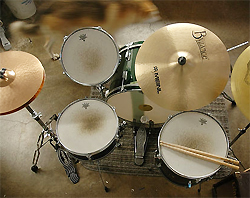Last month I did a guest post for Travis Whitmore’s SilverLake Studio blog as part of his 31 Days to Better Drums series.
My article is below, you can read the rest of the 31 Days to Better Sounding Drums series on Travis’ blog.
The article is not meant to be a tutorial on drum editing, but an overview of the concepts and methods, reasons why you’d want to edit your drum tracks or outsource the work to a pro editor. I also go over why I prefer editing manually in REAPER rather than with the “industry standard” Beat Detective in Pro Tools.
Drum editing
Drum editing has become an absolutely necessary part of the record production process. Out of time drums are one of those things that prevents a recording project from sounding as good as it can. Along with off tune vocals and too much reverb, it is one of the things that keeps home studio productions from sounding like pro recordings.
For the past 3 years I’ve been offering drum editing services to home and pro studios worldwide and today I’ll explain a little of what goes on behind the scenes. This isn’t a tutorial.
Why edit drums?
A lot of people might think this is some cost-cutting or time saving part of recording. It’s absolutely not! Proper drum editing actually takes a lot of time and as the ancient saying goes “time is money”. Editing comes after the drummer has given the best performance possible and the best parts of each take are combined to a composite.
Engineers edit drums to achieve the following:
—Consistent timing and groove
—Replace missed or bad hits
—Create a solid foundation for the rhythm section
I have a lot of respect for drummers. The ones I work with get their parts 80-95 percent perfect. They get me to help with the rest. Drummers have a lot to think about, that hand and foot independence thing, plus keeping time, plus hitting the right drums in the right place, plus remembering the pattern and which ones come next… well that’s a hell of a lot of work, and is physically exhausting. The typical drum recording session for an album is two 8-10 hour days. This definitely demands some respect.
But I don’t want to sound like a robot!
To the drummers: If it’s done right, I guarantee you won’t sound like a robot! The performance will be consistent and powerful and will never fall out of time with the other instruments.
All of the natural nuances of the playing are still there. It’s not about making you sound like a drum machine. We have other ways of achieving that. Beyond that, the bass, guitar, keyboards and other instruments will have a solid foundation for laying down their parts.
Phase accuracy
One of the primary concerns with editing a multi-track drum recording is phase accuracy. If you edit just the kick or snare mic tracks individually, it will be out of time with the overheads and room mics and bleed in other mics. This would be a huge problem, but is easily avoided by using the edit group function in the DAW. An edit group will ensure that when you slice it will apply to all tracks with sample accuracy.
What tracks should be edited
With the tracks grouped, the close mic’ed kick and snare tracks are the primary concerns to get tight. The next important are the toms, after that the ride cymbal. Depending on the project I’ll do all of these to a 16th note grid.
Quantizing methods
Quantizing like with MIDI, means aligning to a grid. There are 3 methods of quantizing drums:
—Time stretching and snapping to grid
—Automatic slicing and snap to grid
—Manual slicing and aligning to grid
I’ve listed these in order of sound quality from worst to best and is also from least time required to most.





















